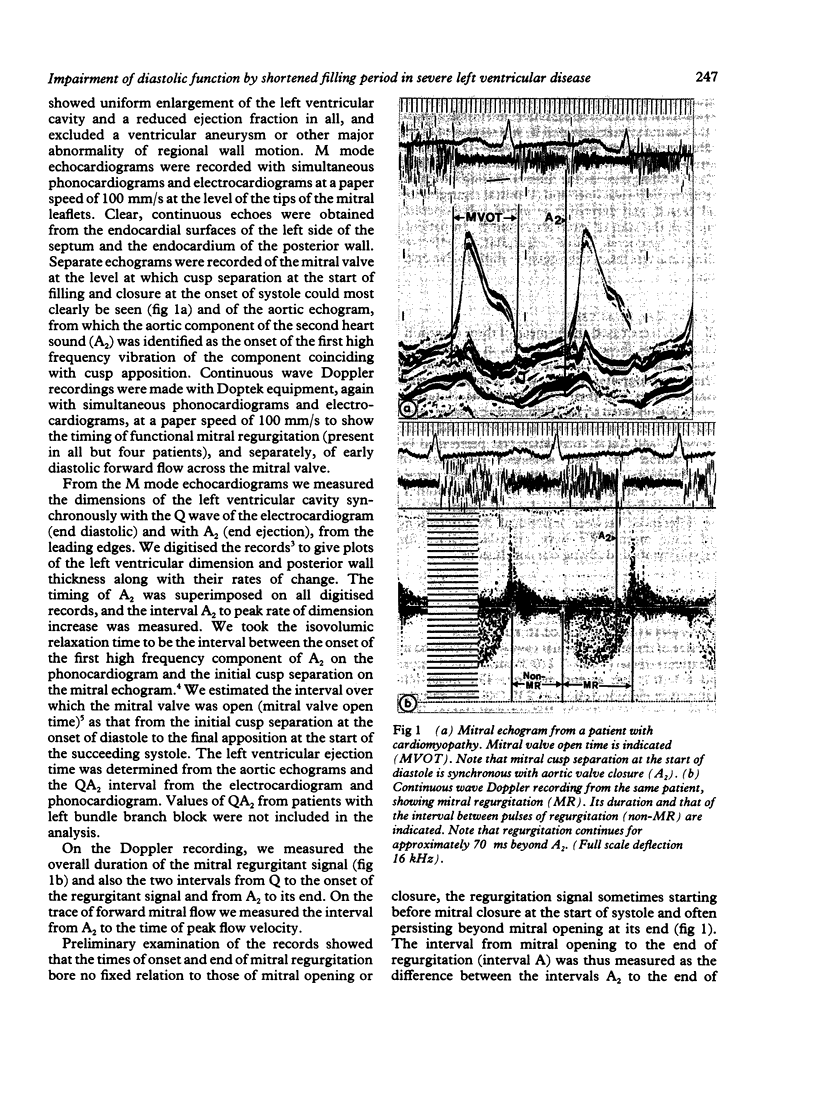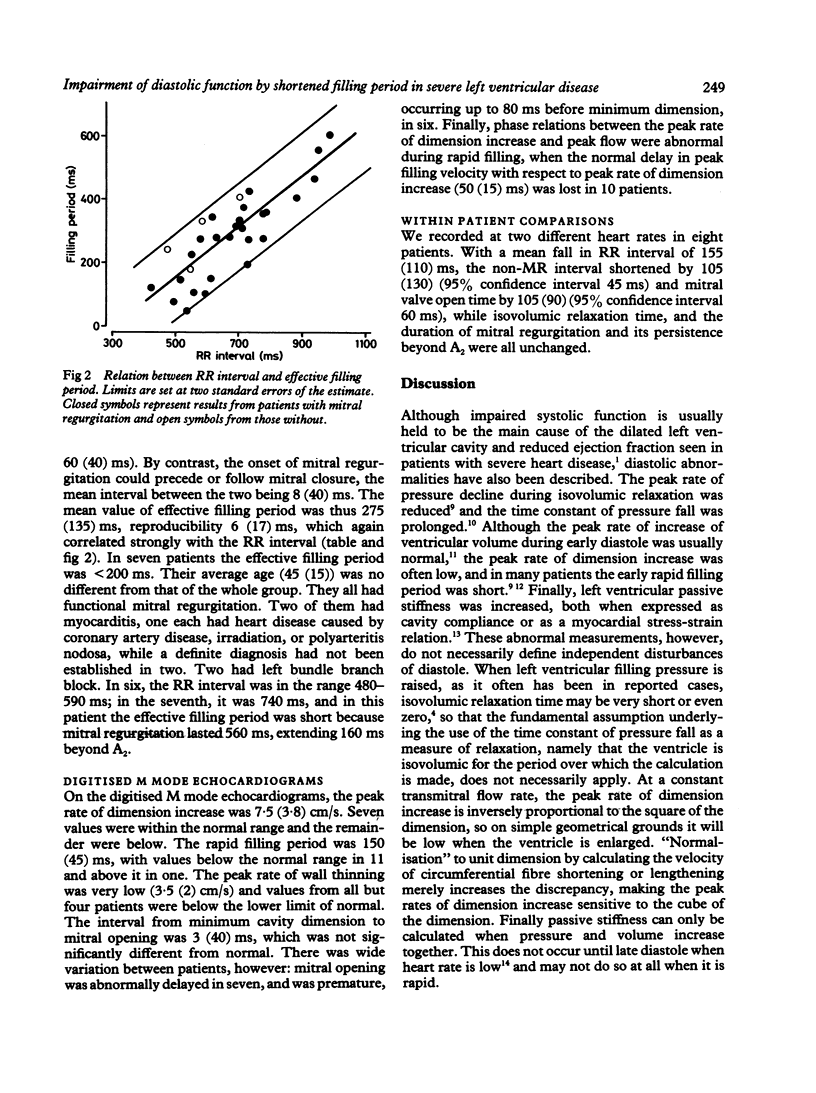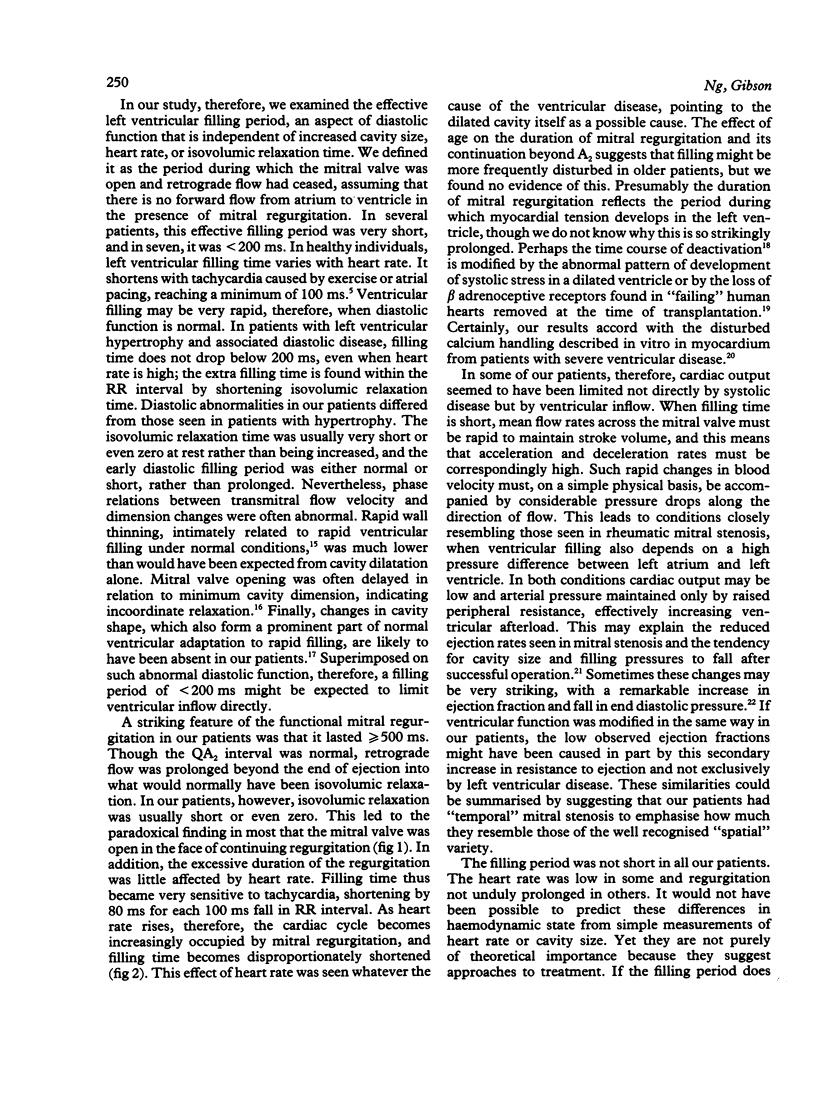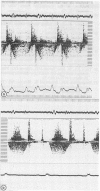Abstract
A dilated left ventricle with reduced ejection fraction is usually attributed to impaired systolic function. To investigate the possibility that ventricular filling might also be disturbed, M mode echocardiograms, phonocardiograms, and Doppler cardiograms were recorded in 30 patients with ventricular disease of varying cause. All but four had functional mitral regurgitation. The size of the left ventricular cavity was increased in all and peak velocity of circumferential fibre shortening was reduced. Diastolic abnormalities included a short isovolumic relaxation time, and, on digitised M mode, a reduced rate of dimension increase and of posterior wall thinning. Although the timing of aortic valve closure was normal, mitral regurgitation persisted beyond it by 95 (35) ms and beyond mitral valve opening by 60 (40) ms. This reduced the effective filling time (the interval when the mitral valve was open and mitral regurgitation was absent) to less than 200 ms in seven patients. The effective filling time correlated closely with the RR interval, the regression equation indicating a reduction of 80 ms for each 100 ms fall in RR interval. It was also independently shortened by 2 ms a year with increasing age. The effective left ventricular filling time may thus be very short in patients with left ventricular cavity dilatation and functional mitral regurgitation. It is suggested that when diastolic function is also abnormal, this short filling time may physically limit ventricular inflow. Its close relation to heart rate might contribute to the therapeutic effect of beta blockade in such patients.
Full text
PDF






Images in this article
Selected References
These references are in PubMed. This may not be the complete list of references from this article.
- Bland J. M., Altman D. G. Statistical methods for assessing agreement between two methods of clinical measurement. Lancet. 1986 Feb 8;1(8476):307–310. [PubMed] [Google Scholar]
- Bristow M. R., Ginsburg R., Minobe W., Cubicciotti R. S., Sageman W. S., Lurie K., Billingham M. E., Harrison D. C., Stinson E. B. Decreased catecholamine sensitivity and beta-adrenergic-receptor density in failing human hearts. N Engl J Med. 1982 Jul 22;307(4):205–211. doi: 10.1056/NEJM198207223070401. [DOI] [PubMed] [Google Scholar]
- Brutsaert D. L., Housmans P. R., Goethals M. A. Dual control of relaxation. Its role in the ventricular function in the mammalian heart. Circ Res. 1980 Nov;47(5):637–652. doi: 10.1161/01.res.47.5.637. [DOI] [PubMed] [Google Scholar]
- Carroll J. D., Lang R. M., Neumann A. L., Borow K. M., Rajfer S. I. The differential effects of positive inotropic and vasodilator therapy on diastolic properties in patients with congestive cardiomyopathy. Circulation. 1986 Oct;74(4):815–825. doi: 10.1161/01.cir.74.4.815. [DOI] [PubMed] [Google Scholar]
- Evans S. J., Mills P., Dawson J. The end of the p value? Br Heart J. 1988 Sep;60(3):177–180. doi: 10.1136/hrt.60.3.177. [DOI] [PMC free article] [PubMed] [Google Scholar]
- Fioretti P., Brower R. W., Meester G. T., Serruys P. W. Interaction of left ventricular relaxation and filling during early diastole in human subjects. Am J Cardiol. 1980 Aug;46(2):197–203. doi: 10.1016/0002-9149(80)90058-2. [DOI] [PubMed] [Google Scholar]
- Gash A. K., Carabello B. A., Cepin D., Spann J. F. Left ventricular ejection performance and systolic muscle function in patients with mitral stenosis. Circulation. 1983 Jan;67(1):148–154. doi: 10.1161/01.cir.67.1.148. [DOI] [PubMed] [Google Scholar]
- Gibson D. G., Brown D. J. Continuous assessment of left ventricular shape in man. Br Heart J. 1975 Sep;37(9):904–910. doi: 10.1136/hrt.37.9.904. [DOI] [PMC free article] [PubMed] [Google Scholar]
- Gibson D. G., Brown D. Measurement of instantaneous left ventricular dimension and filling rate in man, using echocardiography. Br Heart J. 1973 Nov;35(11):1141–1149. doi: 10.1136/hrt.35.11.1141. [DOI] [PMC free article] [PubMed] [Google Scholar]
- Gibson D. G., Prewitt T. A., Brown D. J. Analysis of left ventricular wall movement during isovolumic relaxation and its relation to coronary artery disease. Br Heart J. 1976 Oct;38(10):1010–1019. doi: 10.1136/hrt.38.10.1010. [DOI] [PMC free article] [PubMed] [Google Scholar]
- Grossman W., McLaurin L. P., Rolett E. L. Alterations in left ventricular relaxation and diastolic compliance in congestive cardiomyopathy. Cardiovasc Res. 1979 Sep;13(9):514–522. doi: 10.1093/cvr/13.9.514. [DOI] [PubMed] [Google Scholar]
- Gwathmey J. K., Copelas L., MacKinnon R., Schoen F. J., Feldman M. D., Grossman W., Morgan J. P. Abnormal intracellular calcium handling in myocardium from patients with end-stage heart failure. Circ Res. 1987 Jul;61(1):70–76. doi: 10.1161/01.res.61.1.70. [DOI] [PubMed] [Google Scholar]
- Hammermeister K. E., Warbasse J. R. The rate of change of left ventricular volume in man. II. Diastolic events in health and disease. Circulation. 1974 Apr;49(4):739–747. doi: 10.1161/01.cir.49.4.739. [DOI] [PubMed] [Google Scholar]
- Hui W. K., Gibson D. G. The dynamics of rapid left ventricular filling in man. Adv Cardiol. 1985;32:7–35. doi: 10.1159/000410751. [DOI] [PubMed] [Google Scholar]
- Lewis R. P., Rittogers S. E., Froester W. F., Boudoulas H. A critical review of the systolic time intervals. Circulation. 1977 Aug;56(2):146–158. doi: 10.1161/01.cir.56.2.146. [DOI] [PubMed] [Google Scholar]
- Mattheos M., Shapiro E., Oldershaw P. J., Sacchetti R., Gibson D. G. Non-invasive assessment of changes in left ventricular relaxation by combined phono-, echo-, and mechanocardiography. Br Heart J. 1982 Mar;47(3):253–260. doi: 10.1136/hrt.47.3.253. [DOI] [PMC free article] [PubMed] [Google Scholar]
- Oldershaw P. J., Dawkins K. D., Ward D. E., Gibson D. G. Diastolic mechanisms of impaired exercise tolerance in aortic valve disease. Br Heart J. 1983 Jun;49(6):568–573. doi: 10.1136/hrt.49.6.568. [DOI] [PMC free article] [PubMed] [Google Scholar]
- SONNENBLICK E. H., BRAUNWALD E., MORROW A. G. THE CONTRACTILE PROPERTIES OF HUMAN HEART MUSCLE: STUDIES ON MYOCARDIAL MECHANICS OF SURGICALLY EXCISED PAPILLARY MUSCLES. J Clin Invest. 1965 Jun;44:966–977. doi: 10.1172/JCI105214. [DOI] [PMC free article] [PubMed] [Google Scholar]
- Swedberg K., Hjalmarson A., Waagstein F., Wallentin I. Beneficial effects of long-term beta-blockade in congestive cardiomyopathy. Br Heart J. 1980 Aug;44(2):117–133. doi: 10.1136/hrt.44.2.117. [DOI] [PMC free article] [PubMed] [Google Scholar]
- Traill T. A., St John Sutton M. G., Gibson D. G. Mitral stenosis with high left ventricular diastolic pressure. Br Heart J. 1979 Apr;41(4):405–411. doi: 10.1136/hrt.41.4.405. [DOI] [PMC free article] [PubMed] [Google Scholar]




